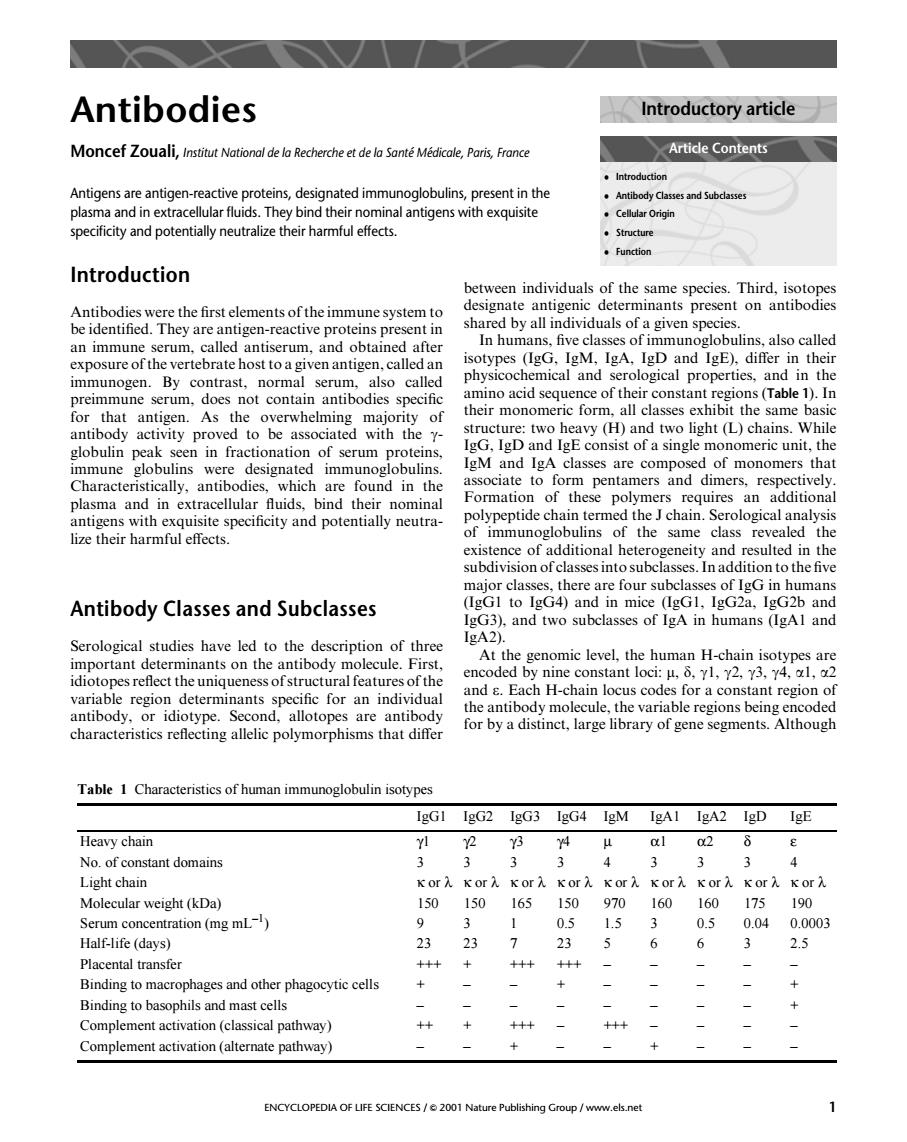正在加载图片...

Antibodies Introductory article Moncef National de Recherche et de Snt Medicale,Pris,France Artice Contents Introduction Antigensareantigen-reactive proteins,esignated,presentinthe Antibody Classes and Subdasses plasma and in extracellular fluids.They bind their nominal antigens with exquisite Cellular Origin specificity and potentially neutralize their harmful effects. Functio Introduction Antibodies were the first elements ofthe immune system to beidentiel.TheyareantienrCactreprotcinspregen shared by all individuals of a given species m and obtained In hum ns,five classes of immunoglobulins,also called d sotypes (IgG.IgM.IgA.IgD and IgE).differ in thei immunogen.By contrast.normal serum.also called of the preimmune serum,does not contain antibodies specific s (Table 1).In for that ani their monomeric form.all classes exhibit the same basic As the be structure:two heavy (H)and two light(L)chains.While lobun serum prote IgD an gE consist of a single monomeric unit, Characteristically,antibodies,which are found in the bind the nomina Formation of these polymers requires an additional subdivision In addition to the five major classes,there are four subclasses of IgG in humans Antibody Classes and Subclasses (IgGl to IgG4)and in mice (IgGl,IgG2a,IgG2b and g).and two subclasses of igA in humans l and it the omic level the human H-chain idiotopes reflect the uniqueness ofstructural features of the adpeminapeicoranindiid ind s.Each H-chain locus codes for a constant region o ay mo the vana e regions b allelic polymorp Table 1 Characteristics of human immunoglobulin isotypes IgGI IgG2 IgG3 IgG4 IgM IgAl IgA2 IgD IgE Heavy chain e No.of constant domains 3 Light chain ,Kor Kor入Kor入Kor Kor Kor入Kor入Kor Molecular weight(kDa) 150 150 165 150 970 160 160 175 190 Serum concentration(mg mL-1) 9 3 05 1.5 3 0.5 0.04 0.0003 Half-life (davs) 23 23 7 23 5 6 6 3 2.5 Placental transfer ++++ +十++++ Binding to macrophages and other phagocytic cells + + 、 Binding to basophils and mast cells Comple (classical pathway + Complement activation(alternate pathway) ENCYCLOPEDIA OF LIFE SCIENCES/2001 Nature Publishing Group /www.els.net Antibodies Moncef Zouali, Institut National de la Recherche et de la Sante´ Me´dicale, Paris, France Antigens are antigen-reactive proteins, designated immunoglobulins, present in the plasma and in extracellular fluids. They bind their nominal antigens with exquisite specificity and potentially neutralize their harmful effects. Introduction Antibodies were the first elements of the immune system to be identified. They are antigen-reactive proteins present in an immune serum, called antiserum, and obtained after exposure of the vertebrate host to a given antigen, called an immunogen. By contrast, normal serum, also called preimmune serum, does not contain antibodies specific for that antigen. As the overwhelming majority of antibody activity proved to be associated with the gglobulin peak seen in fractionation of serum proteins, immune globulins were designated immunoglobulins. Characteristically, antibodies, which are found in the plasma and in extracellular fluids, bind their nominal antigens with exquisite specificity and potentially neutralize their harmful effects. Antibody Classes and Subclasses Serological studies have led to the description of three important determinants on the antibody molecule. First, idiotopes reflect the uniqueness of structural features of the variable region determinants specific for an individual antibody, or idiotype. Second, allotopes are antibody characteristics reflecting allelic polymorphisms that differ between individuals of the same species. Third, isotopes designate antigenic determinants present on antibodies shared by all individuals of a given species. In humans, five classes of immunoglobulins, also called isotypes (IgG, IgM, IgA, IgD and IgE), differ in their physicochemical and serological properties, and in the amino acid sequence of their constant regions (Table 1). In their monomeric form, all classes exhibit the same basic structure: two heavy (H) and two light (L) chains. While IgG, IgD and IgE consist of a single monomeric unit, the IgM and IgA classes are composed of monomers that associate to form pentamers and dimers, respectively. Formation of these polymers requires an additional polypeptide chain termed the J chain. Serological analysis of immunoglobulins of the same class revealed the existence of additional heterogeneity and resulted in the subdivision of classes into subclasses. In addition to the five major classes, there are four subclasses of IgG in humans (IgG1 to IgG4) and in mice (IgG1, IgG2a, IgG2b and IgG3), and two subclasses of IgA in humans (IgA1 and IgA2). At the genomic level, the human H-chain isotypes are encoded by nine constant loci: m, d, g1, g2, g3, g4, a1, a2 and e. Each H-chain locus codes for a constant region of the antibody molecule, the variable regions being encoded for by a distinct, large library of gene segments. Although Article Contents Introductory article . Introduction . Antibody Classes and Subclasses . Cellular Origin . Structure . Function Table 1 Characteristics of human immunoglobulin isotypes IgG1 IgG2 IgG3 IgG4 IgM IgA1 IgA2 IgD IgE Heavy chain γ1 γ2 γ3 γ4 µ α1 α2 δ ε No. of constant domains 3 3 3 3 4 3 3 3 4 Light chain κ or λ κ or λ κ or λ κ or λ κ or λ κ or λ κ or λ κ or λ κ or λ Molecular weight (kDa) 150 150 165 150 970 160 160 175 190 Serum concentration (mg mL–1) 9 3 1 0.5 1.5 3 0.5 0.04 0.0003 Half-life (days) 23 23 7 23 5 6 6 3 2.5 Placental transfer +++ + +++ +++ – – – – – Binding to macrophages and other phagocytic cells + – – + – – – – + Binding to basophils and mast cells – – – – – – – – + Complement activation (classical pathway) ++ + +++ – +++ – – – – Complement activation (alternate pathway) – – + – – + – – – ENCYCLOPEDIA OF LIFE SCIENCES / & 2001 Nature Publishing Group / www.els.net 1